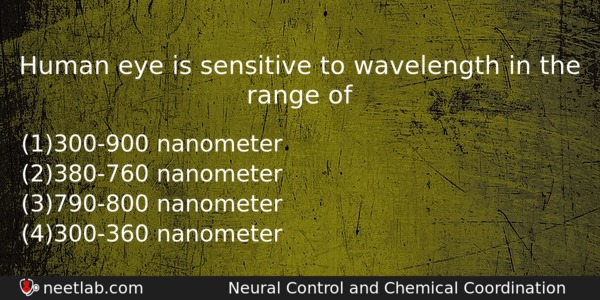| ⇦ | 
| ⇨ |
Human eye is sensitive to wavelength in the range of
Options
(a) 300-900 nanometer
(b) 380-760 nanometer
(c) 790-800 nanometer
(d) 300-360 nanometer
Correct Answer:
380-760 nanometer
Explanation:
400 to 700 nm range of wavelength are “visible” because these are the wavelengths to which our eyes are sensitive. The cone cells of the human eye are sensitive to 3 wavelength ranges which the eye interprets as blue (narrow, with a peak near 419nm), green (broader, with a peak near 531 nm) and red (also broad, with a peak near 558nm, which is actually more like yellow).
Related Questions: - Ubisch bodies are present in
- Genetic engineering has been successfully used for producing:
- In the case of peppered moth (Biston betularia) the black
- Joined green stem occurs in
- In genetic engineering experiment, DNA fragments are joined by
Topics: Neural Control and Chemical Coordination
(195)
Subject: Biology
(4253)
Important MCQs Based on Medical Entrance Examinations To Improve Your NEET Score
- Ubisch bodies are present in
- Genetic engineering has been successfully used for producing:
- In the case of peppered moth (Biston betularia) the black
- Joined green stem occurs in
- In genetic engineering experiment, DNA fragments are joined by
Topics: Neural Control and Chemical Coordination (195)
Subject: Biology (4253)
Important MCQs Based on Medical Entrance Examinations To Improve Your NEET Score
18000+ students are using NEETLab to improve their score. What about you?
Solve Previous Year MCQs, Mock Tests, Topicwise Practice Tests, Identify Weak Topics, Formula Flash cards and much more is available in NEETLab Android App to improve your NEET score.
Share this page with your friends

Leave a Reply